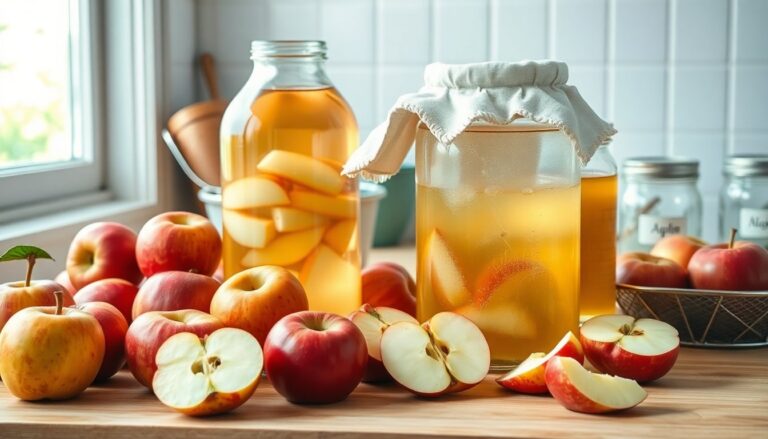Argomenti trattati
Creating your own apple cider vinegar (ACV) not only allows for the utilization of surplus apples but also offers a healthier and more cost-effective alternative to store-bought options. This versatile ingredient can be used in various recipes, health applications, and even cleaning solutions. This guide outlines a straightforward process for making ACV at home, enabling you to maximize the use of your apples while reaping the benefits of fermentation.
Understanding the basics of apple cider vinegar
Apple cider vinegar results from a fermentation process in which sugars are converted into alcohol and subsequently transformed into acetic acid. This acetic acid is the key component that imparts vinegar its distinct flavor and health benefits. Homemade ACV often contains a richer profile of beneficial probiotics compared to commercial varieties, which may be pasteurized or filtered, diminishing their natural properties.
The health benefits of apple cider vinegar
Incorporating homemade apple cider vinegar into your daily routine can yield numerous health advantages. It is known to aid digestion, support gut health, and help regulate blood sugar levels. For individuals with diabetes, studies indicate that consuming ACV before meals can enhance glucose management. Additionally, the presence of probiotics in fermented foods like ACV can strengthen the immune system.
The process of making apple cider vinegar
Making your own apple cider vinegar is a rewarding endeavor that can be accomplished in a few straightforward steps. You can use whole apples or apple scraps—regardless, you’ll be minimizing waste while creating something beneficial. To begin, gather your ingredients: fresh apples, sugar, and water.
Step-by-step guide
1. Preparation of apples: If using whole apples, wash them thoroughly to remove any contaminants. Chop them into small pieces, including the skins and cores, as they contain valuable nutrients. If you prefer to use scraps, ensure they’ve been thawed if previously frozen.
2. Creating the mixture: Fill a clean glass container halfway with the chopped apples or scraps. Pour in enough filtered water to cover the apples completely, keeping track of the water volume. For every cup of water, add one tablespoon of sugar to promote the fermentation process. Stir until the sugar is fully dissolved.
3. Encouraging fermentation: To kickstart the fermentation, you can add a splash of store-bought ACV that contains the mother—a colony of beneficial bacteria. Cover the container with a breathable fabric—such as cheesecloth or a clean kitchen towel—to allow air circulation while keeping out debris.
4. Monitoring the process: Place the container in a warm, dark spot, ideally between 70°F and 75°F. For the first two weeks, stir the mixture daily to prevent mold and ensure even fermentation. You may notice bubbles forming and a change in smell, indicating that fermentation is underway.
5. Straining and aging: After two weeks, strain the mixture to separate the liquid from the solids. The remaining liquid is your raw apple cider vinegar, which needs to be aged for an additional month or two to develop its flavor fully. Store it covered with the same breathable cloth to allow the fermentation to continue.
6. Tasting and bottling: After about a month, taste your vinegar. If it meets your flavor preference, transfer it into clean bottles for storage. Homemade apple cider vinegar can last for several years when stored properly, though its flavor is best enjoyed within the first two years.
Utilizing your homemade apple cider vinegar
Apple cider vinegar results from a fermentation process in which sugars are converted into alcohol and subsequently transformed into acetic acid. This acetic acid is the key component that imparts vinegar its distinct flavor and health benefits. Homemade ACV often contains a richer profile of beneficial probiotics compared to commercial varieties, which may be pasteurized or filtered, diminishing their natural properties.0
Apple cider vinegar results from a fermentation process in which sugars are converted into alcohol and subsequently transformed into acetic acid. This acetic acid is the key component that imparts vinegar its distinct flavor and health benefits. Homemade ACV often contains a richer profile of beneficial probiotics compared to commercial varieties, which may be pasteurized or filtered, diminishing their natural properties.1

